Investigation of the Gel Properties and Gelation Mechanism of a Surimi Blend Composed of Skipjack Tuna (Katsuwonus pelamis) and Purpleback Flying Squid (Symplectoteuthis oualaniensis)
Abstract
1. Introduction
2. Materials and Methods
2.1. Materials and Surimi Gel Preparation
2.2. Textural Profile Analysis
2.3. Penetration Test
2.4. Water Holding Capacity and Cooking Loss Measurement
2.5. Whiteness Measurement
2.6. Rheological Characteristics Measurement
2.6.1. Apparent Viscosity
2.6.2. Dynamic Rheology
2.7. Fourier Transform Infrared (FTIR) Spectroscopy
2.8. Molecular Forces Measurement
2.9. Differential Scanning Calorimetry (DSC)
2.10. Microstructure Observation
2.11. Data Analysis
3. Results and Discussion
3.1. Gel Strength and WHC

3.2. Textural Properties
3.3. Cooking Loss
3.4. Color
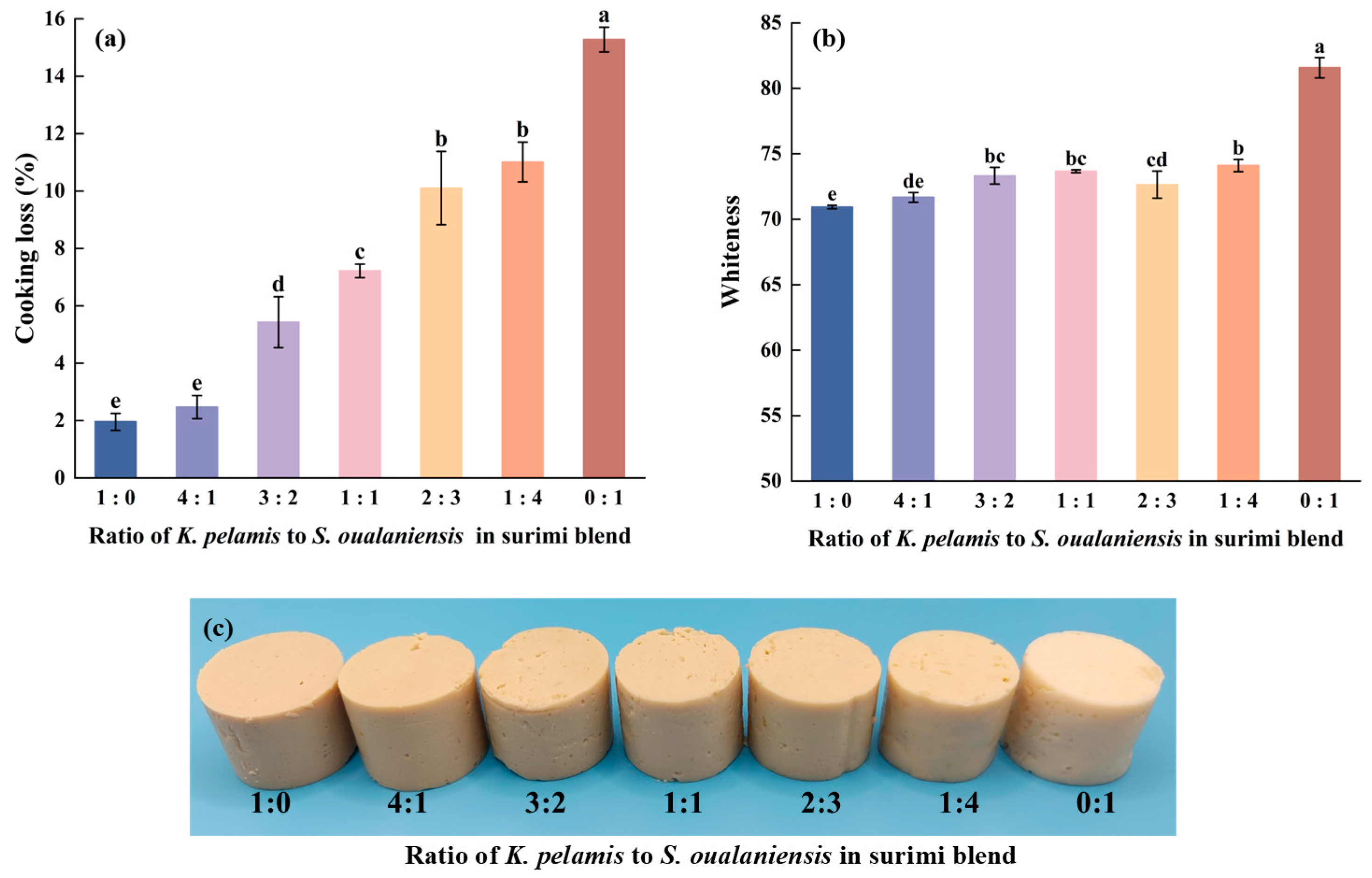
3.5. Rheological Properties
3.5.1. Dynamic Rheological Properties
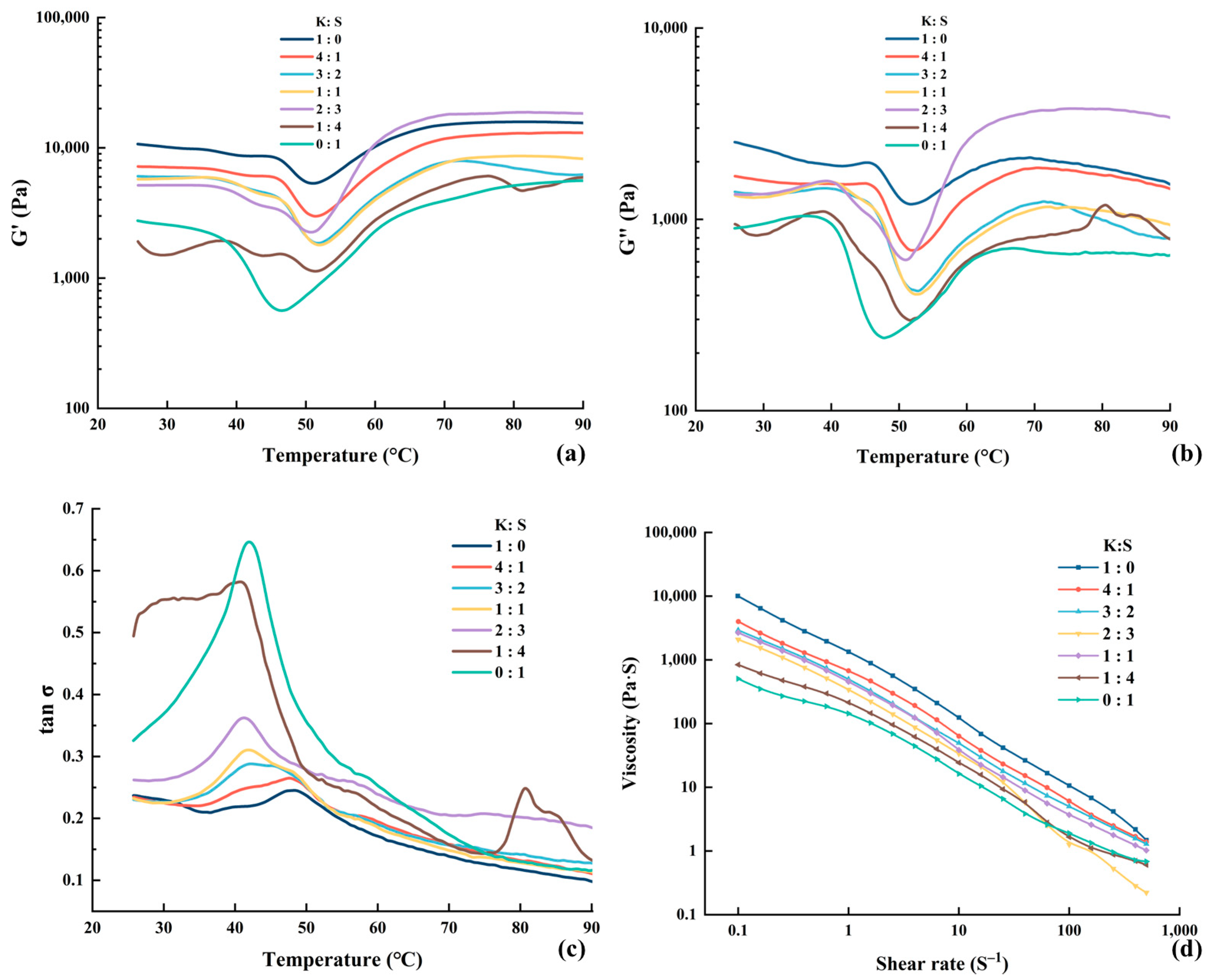
3.5.2. Apparent Viscosity Profile
3.6. Molecular Forces
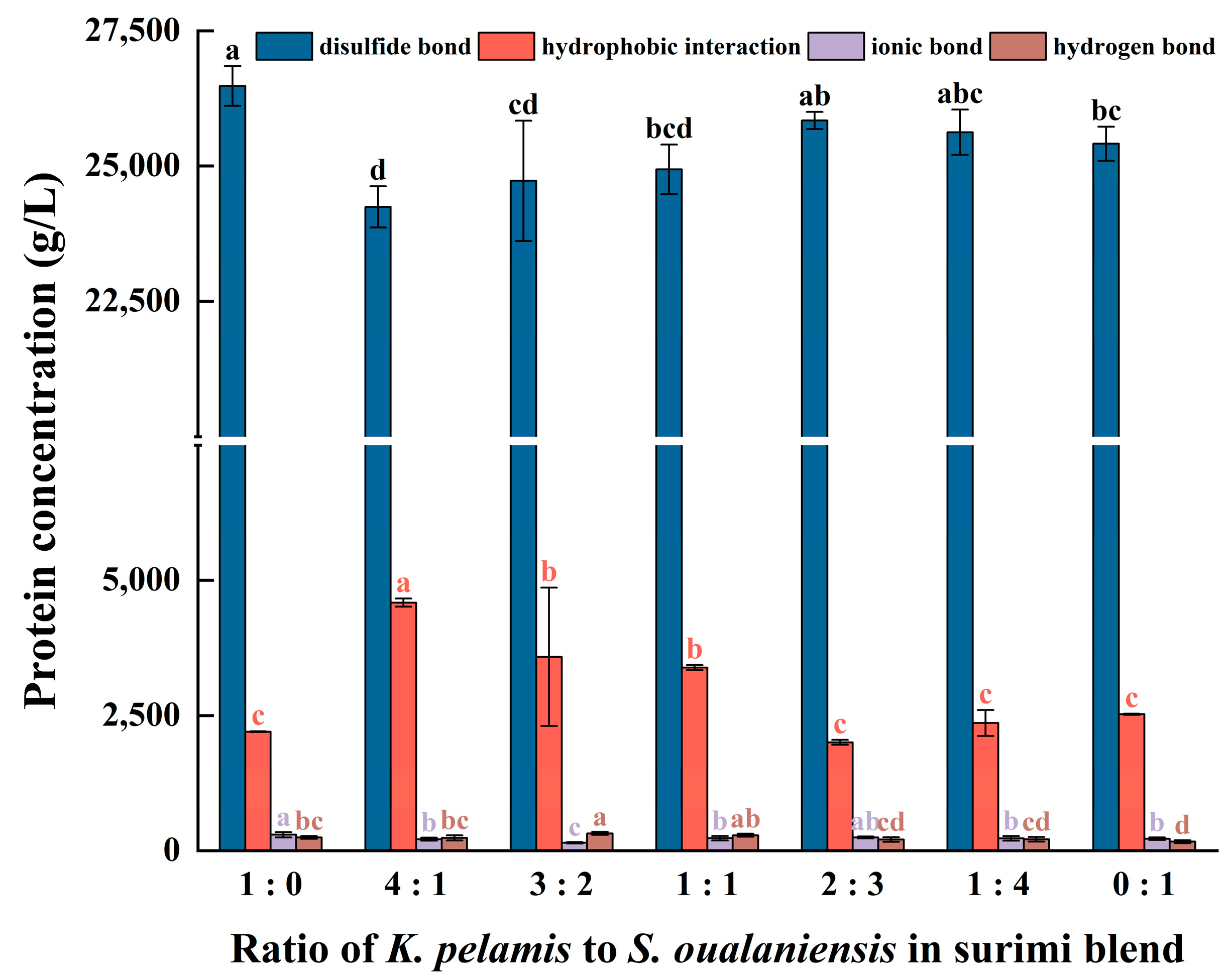
3.7. DSC
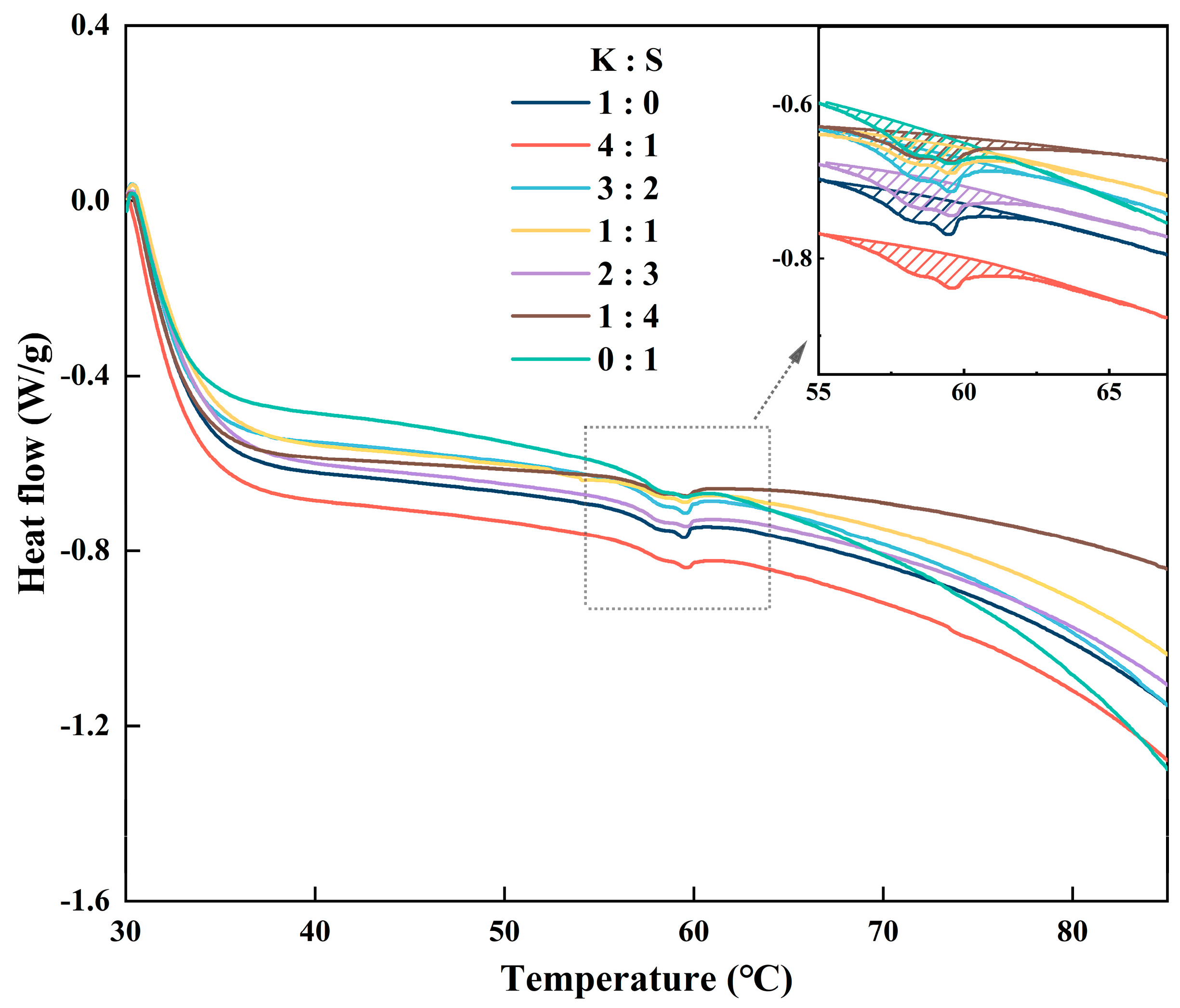
3.8. FTIR
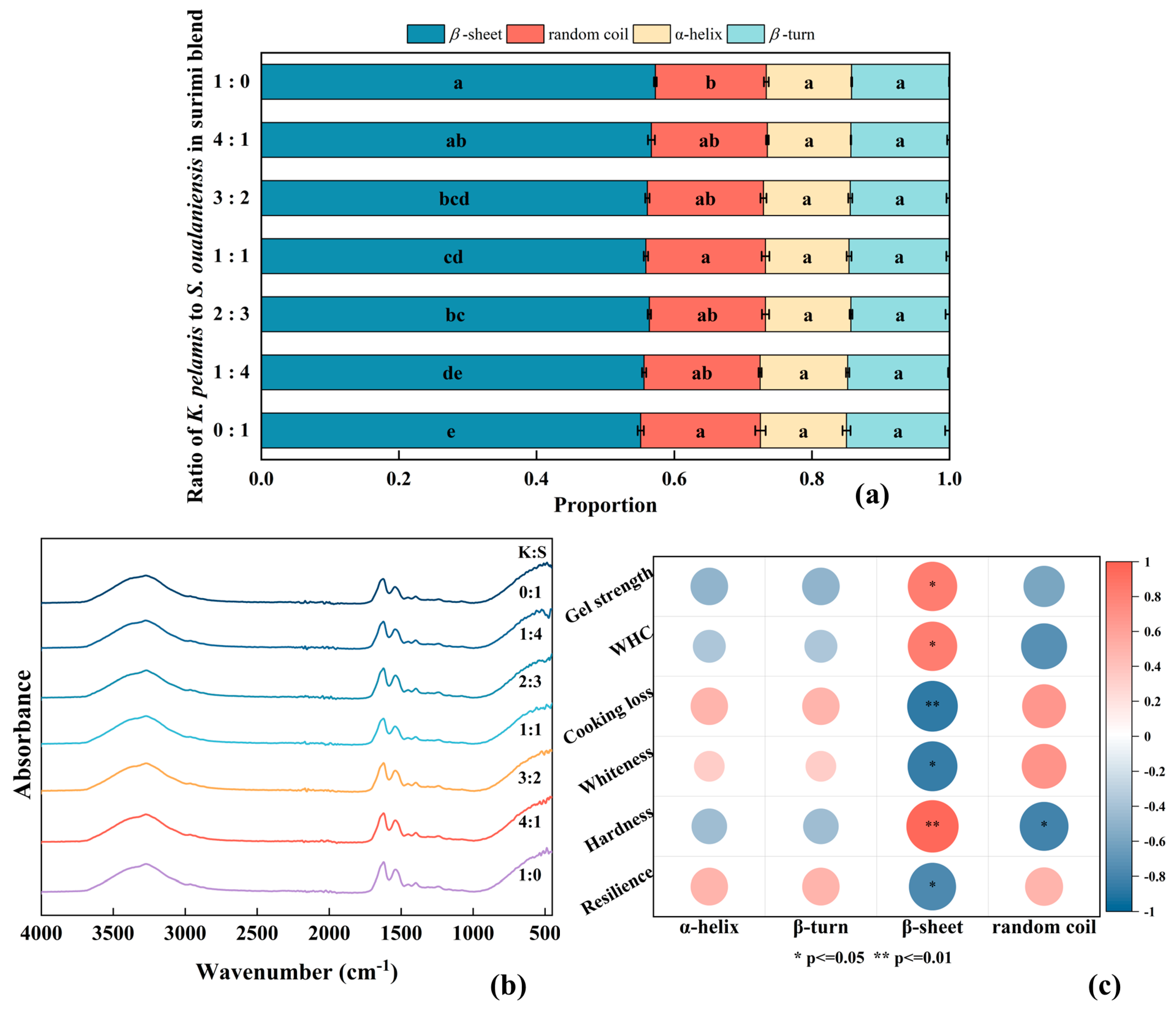
3.9. Microstructure
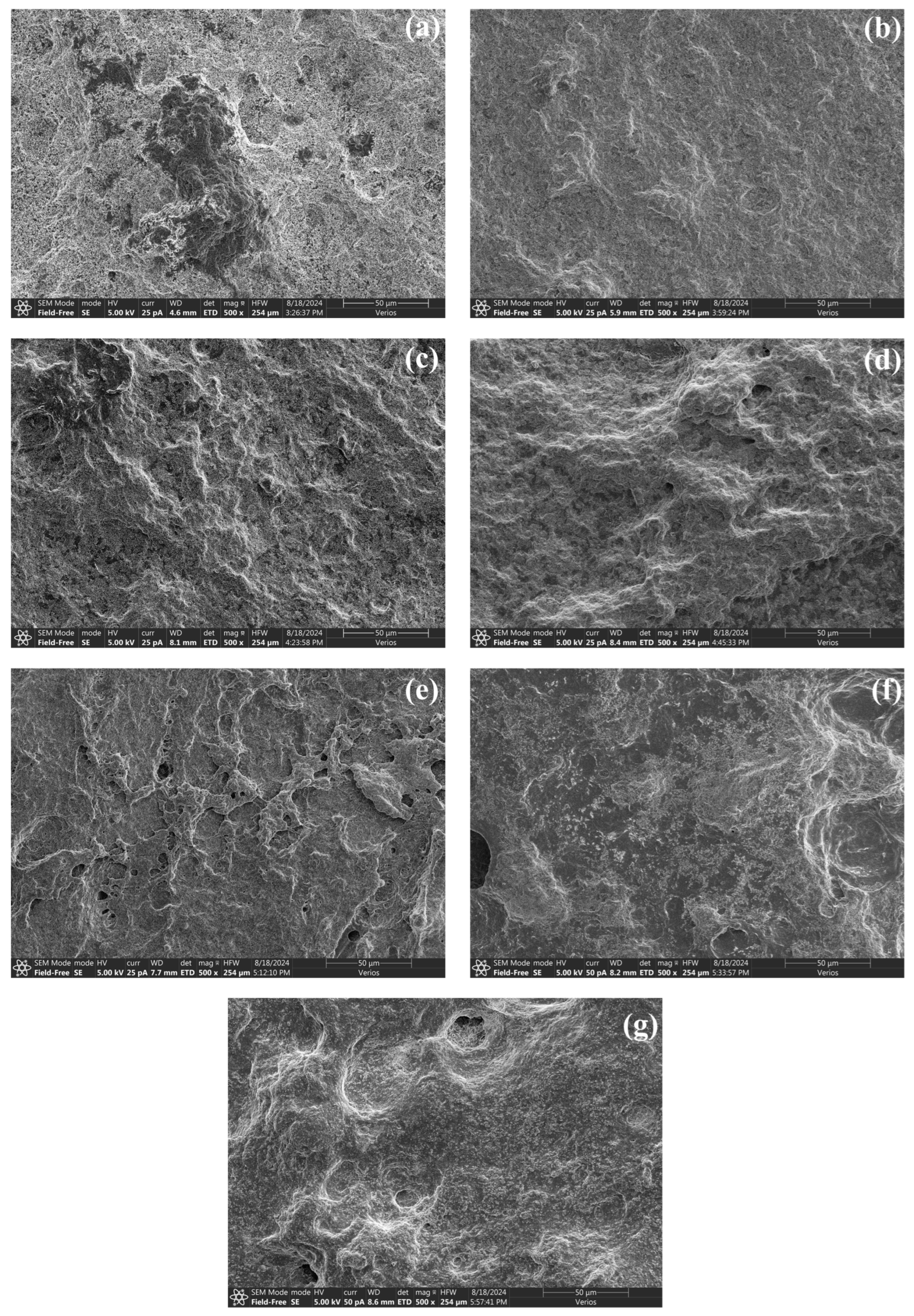
4. Conclusions
Author Contributions
Funding
Institutional Review Board Statement
Informed Consent Statement
Data Availability Statement
Acknowledgments
Conflicts of Interest
Abbreviations
| DSC | Differential scanning calorimetry |
References
- FAO. In Brief to The State of World Fisheries and Aquaculture 2022. Blue Transformation in Action; FAO: Rome, Italy, 2024. [Google Scholar]
- Fan, J.; Fang, Z.; Ma, S.; Zhang, P.; Chen, Z. Age, growth, and population characteristics of Sthenoteuthis oualaniensis in the South China Sea. Reg. Stud. Mar. Sci. 2022, 55, 102517. [Google Scholar] [CrossRef]
- Zhao, C.; Shen, C.; Bakun, A.; Yan, Y.; Kang, B.; Zhao, C.; Shen, C.; Bakun, A.; Yan, Y.; Kang, B. Purpleback Flying Squid Sthenoteuthis oualaniensis in the South China Sea: Growth, Resources and Association with the Environment. Water 2021, 13, 65. [Google Scholar] [CrossRef]
- Zhang, J.; Chen, Z.-Z.; Chen, G.-B.; Zhang, P.; Qiu, Y.-S.; Yao, Z. Hydroacoustic studies on the commercially important squid Sthenoteuthis oualaniensis in the South China Sea. Fish. Res. 2015, 169, 45–51. [Google Scholar] [CrossRef]
- Lu, H.; Chen, Z.; Liu, K.; Ou, Y.; Zhao, M.; Sun, T.; Lu, H.; Chen, Z.; Liu, K.; Ou, Y.; et al. Statolith Microstructure Estimates of the Age, Growth, and Population Structure of Purpleback Flying Squid (Sthenoteuthis oualaniensis) in the Waters of the Xisha Islands of the South China Sea. Fishes 2022, 7, 234. [Google Scholar] [CrossRef]
- Zhou, X.; Chen, T.; Lin, H.; Chen, H.; Liu, J.; Lyu, F.; Ding, Y. Physicochemical properties and microstructure of surimi treated with egg white modified by tea polyphenols. Food Hydrocoll. 2019, 90, 82–89. [Google Scholar] [CrossRef]
- Yi, S.; Huo, Y.; Qiao, C.; Wang, W.; Li, X. Synergistic Gelation Effects in Surimi Mixtures Composed of Nemipterus virgatus and Hypophthalmichtys molitrix. J. Food Sci. 2019, 84, 3634–3641. [Google Scholar] [CrossRef]
- Cortés-Ruiz, J.A.; Pacheco-Aguilar, R.; Ramírez-Suárez, J.C.; Lugo-Sánchez, M.E.; García-Orozco, K.D.; Sotelo-Mundo, R.R.; Peña-Ramos, A. Conformational changes in proteins recovered from jumbo squid (Dosidicus gigas) muscle through pH shift washing treatments. Food Chem. 2016, 196, 769–775. [Google Scholar] [CrossRef] [PubMed]
- Nagashima, Y.; Ebina, H.; Nagai, T.; Tanaka, M.; Taguchi, T. Proteolysis Affects Thermal Gelation of Squid Mantle Muscle. J. Food Sci. 1992, 57, 916. [Google Scholar] [CrossRef]
- Park, S.; CHO, S.; Yoshioka, T.; Kimura, M.; Nozawa, H.; Seki, N. Influence of Endogenous Proteases and Transglutaminase on Thermal Gelation of Salted Squid Muscle Paste. J. Food Sci. 2003, 68, 2473–2478. [Google Scholar] [CrossRef]
- Ayensa, M.G.; Montero, M.P.; Borderías, A.J.; Hurtado, J.L. Influence of Some Protease Inhibitors on Gelation of Squid Muscle. J. Food Sci. 2002, 67, 1636–1641. [Google Scholar] [CrossRef]
- Gómez-Guillén, M.; Montero, P.; Solas, M.; Borderías, A. Thermally Induced Aggregation of Giant Squid (Dosidicus gigas) Mantle Proteins. Physicochemical Contribution of Added Ingredients. J. Agric. Food. Chem. 1998, 46, 3440–3446. [Google Scholar] [CrossRef][Green Version]
- Panpipat, W.; Chaijan, M.; Benjakul, S. Gel properties of croaker-mackerel surimi blend. Food Chem. 2010, 122, 1122–1128. [Google Scholar] [CrossRef]
- Hoque, M.S.; Roy, S.; Mukit, S.S.; Rahman, M.B.; Akter, S. Effects of Pangasius (Pangasius hypophthalmus) and Skipjack Tuna (Sarda orientalis) mince blend on the quality of fish products: Ways to utilize resources and nutrition in Bangladesh. Food Sci. Nutr. 2021, 9, 6642–6652. [Google Scholar] [CrossRef] [PubMed]
- Zhang, K.; Zhang, J.; Zhang, P.; Su, L.; Hong, X.; Qiu, Y.; Chen, Z. Frontiers | This is what we know: Assessing the stock status of the data-poor skipjack tuna (Katsuwonus pelamis) fishery in the South China Sea. Front. Mar. Sci. 2023, 10, 1095411. [Google Scholar] [CrossRef]
- Kaewudom, P.; Benjakul, S.; Kijroongrojana, K. Properties of surimi gel as influenced by fish gelatin and microbial transglutaminase. Food Biosci. 2013, 1, 39–47. [Google Scholar] [CrossRef]
- Zhao, Y.; Wei, G.; Li, J.; Tian, F.; Zheng, B.; Gao, P.; Zhou, R. Comparative study on the effect of different salts on surimi gelation and gel properties. Food Hydrocoll. 2023, 144, 108982. [Google Scholar] [CrossRef]
- Yang, Z.; Wang, W.; Wang, H.; Ye, Q. Effects of a highly resistant rice starch and preincubation temperatures on the physicochemical properties of surimi gel from grass carp (Ctenopharyn Odon Idellus). Food Chem. 2014, 145, 212–219. [Google Scholar] [CrossRef] [PubMed]
- PARK, J.W. Functional Protein Additives in Surimi Gels. J. Food Sci. 1994, 59. [Google Scholar] [CrossRef]
- Liu, K.; Zhao, N.; Xiang, C.; Li, Y.; Jiang, X.; Zeng, M.; Xu, H.; Wang, H.; Wu, H.; Yu, X.; et al. Three-Dimensional Printing Properties of Polysaccharide Hydrocolloids–Unrinsed Sturgeon Surimi Complex Hydrogels. Foods 2022, 11, 2947. [Google Scholar] [CrossRef] [PubMed]
- Zhao, Y.; Piao, X.; Zheng, B.; Gao, P.; Miao, W.; Wen, Z.; Zhang, X.; Mei, G.; Zhou, R.; Deng, S. Enhancement of surimi gel properties through the synergetic effect of fucoidan and oligochitosan. Food Hydrocoll. 2023, 140, 108626. [Google Scholar] [CrossRef]
- Yongsawatdigul, J.; Carvajal-Rondanelli, P.; Lanier, T. Surimi Gelation Chemistry; CRC Press: Boca Raton, FL, USA, 2005; pp. 435–489. [Google Scholar]
- Hernández-Robledo, V.; Martínez Maldonado, M.Á.; Uresti-Marín, R.M.; Ramírez, J.A.; Velázquez, G. Effect of washing treatment and microbial transglutaminase on the gelling properties of blue crab (Callinectes sapidus) proteins. CyTA J. Food 2017, 15, 165–170. [Google Scholar] [CrossRef]
- Ahhmed, A.M.; Nasu, T.; Huy, D.Q.; Tomisaka, Y.; Kawahara, S.; Muguruma, M. Effect of microbial transglutaminase on the natural actomyosin cross-linking in chicken and beef. Meat Sci. 2009, 82, 170–178. [Google Scholar] [CrossRef] [PubMed]
- Zhu, Z.; Lanier, T.C.; Farkas, B.E.; Li, B. Transglutaminase and high pressure effects on heat-induced gelation of Alaska pollock (Theragra chalcogramma) surimi. J. Food Eng. 2014, 131, 154–160. [Google Scholar] [CrossRef]
- Fowler, M.R.; Park, J.W. Effect of salmon plasma protein on Pacific whiting surimi gelation under various ohmic heating conditions. LWT-Food Sci. Technol. 2015, 61, 309–315. [Google Scholar] [CrossRef]
- Binsi, P.K.; Shamasundar, B.A. Purification and characterization of transglutaminase from four fish species: Effect of added transglutaminase on the viscoelastic behavior of fish mince. Food Chem. 2012, 132, 1922–1929. [Google Scholar] [CrossRef]
- Ma, X.-S.; Yi, S.-M.; Yu, Y.-M.; Li, J.-R.; Chen, J.-R. Changes in gel properties and water properties of Nemipterus virgatus surimi gel induced by high-pressure processing. LWT-Food Sci. Technol. 2015, 61, 377–384. [Google Scholar] [CrossRef]
- Zhao, Y.; Wei, K.; Chen, J.; Wei, G.; Li, J.; Zheng, B.; Song, Y.; Gao, P.; Zhou, R. Enhancement of myofibrillar protein gelation by plant proteins for improved surimi gel characteristics: Mechanisms and performance. LWT 2024, 198, 116045. [Google Scholar] [CrossRef]
- Singh, A.; Benjakul, S. Effect of serine protease inhibitor from squid ovary on gel properties of surimi from Indian mackerel. J. Texture Stud. 2017, 48, 541–549. [Google Scholar] [CrossRef]
- Abdollahi, M.; Rezaei, M.; Jafarpour, A.; Undeland, I. Dynamic rheological, microstructural and physicochemical properties of blend fish protein recovered from kilka (Clupeonella cultriventris) and silver carp (Hypophthalmichthys molitrix) by the pH-shift process or washing-based technology. Food Chem. 2017, 229, 695–709. [Google Scholar] [CrossRef] [PubMed]
- Zhang, L.-D.; Liu, Y.; Wang, Y.-R.; Zhou, T.-Q.; Liu, J.-C.; Yan, J.-N.; Lai, B.; Wang, C.; Wu, H.-T. Gelation melioration of clam Meretrix meretrix surimi based on the interactions with different plant/animal proteins. Food Chem. 2025, 467, 142269. [Google Scholar] [CrossRef] [PubMed]
- Zhang, L.-D.; Li, L.; Zhang, Q.; Wang, Y.-Q.; Liu, Y.; Yan, J.-N.; Lai, B.; Wang, C.; Wu, H.-T. Impact of plant and animal proteins with transglutaminase on the gelation properties of clam Meretrix meretrix surimi. Food Biosci. 2024, 61, 104915. [Google Scholar] [CrossRef]
- Ehara, T.; Nakagawa, K.; Tamiya, T.; Noguchi, S.F.; Tsuchiya, T. Effect of paramyosin on invertebrate natural actomyosin gel formation. Fish. Sci. 2004, 70, 306–313. [Google Scholar] [CrossRef]
- Yang, Y.; Liu, X.; Xue, Y.; Xue, C.; Zhao, Y. The process of heat-induced gelation in Litopenaeus vannamei. Food Hydrocoll. 2020, 98, 105260. [Google Scholar] [CrossRef]
- Niu, F.; Li, X.; Lin, C.; Hu, X.; Zhang, B.; Pan, W. The mechanism of egg white protein to enhance the thermal gel properties of giant squid (Dosidicus gigas) surimi. Food Chem. 2025, 469, 142601. [Google Scholar] [CrossRef]
- Hughes, J.M.; Oiseth, S.K.; Purslow, P.P.; Warner, R.D. A structural approach to understanding the interactions between color, water-holding capacity and tenderness. Meat Sci. 2014, 98, 520–532. [Google Scholar] [CrossRef] [PubMed]
- Chaijan, M.; Benjakul, S.; Visessanguan, W.; Lee, S.; Faustman, C. The Effect of Freezing and Aldehydes on the Interaction between Fish Myoglobin and Myofibrillar Proteins. J. Agric. Food. Chem. 2007, 55, 4562–4568. [Google Scholar] [CrossRef] [PubMed]
- Duan, W.; Qiu, H.; Htwe, K.K.; Wang, Z.; Liu, Y.; Wei, S.; Xia, Q.; Sun, Q.; Han, Z.; Liu, S. Correlation between Water Characteristics and Gel Strength in the Gel Formation of Golden Pompano Surimi Induced by Dense Phase Carbon Dioxide. Foods 2023, 12, 1090. [Google Scholar] [CrossRef] [PubMed]
- Liu, L.; Luo, Y.; Song, Y.; Shen, H.; Hong, H. Study on Gel Properties of Silver Carp (Hypophthalmichthys molitrix) and White Croaker (Argyrosomus argentatus) Blended Surimi at Different Setting Conditions. J. Aquat. Food Prod. Technol. 2012, 22, 36–46. [Google Scholar] [CrossRef]
- Fan, X.; Geng, W.; Li, M.; Wu, Z.; Li, Y.; Yu, S.; Zhao, G.; Zhao, Q. Performance and protein conformation of thermally treated silver carp (Hypophthalmichthys molitrix) and scallop (Argopecten irradians) blended gels. J. Sci. Food Agric. 2024, 104, 7797–7808. [Google Scholar] [CrossRef]
- Rawdkuen, S.; Benjakul, S.; Visessanguan, W.; Lanier, T.C. Effect of cysteine proteinase inhibitor containing fraction from chicken plasma on autolysis and gelation of Pacific whiting surimi. Food Hydrocoll. 2007, 21, 1209–1216. [Google Scholar] [CrossRef]
- Rawdkuen, S.; Benjakul, S.; Visessanguan, W.; Lanier, T.C. Chicken plasma protein: Proteinase inhibitory activity and its effect on surimi gel properties. Food Res. Int. 2004, 37, 156–165. [Google Scholar] [CrossRef]
- Núñez-Flores, R.; Cando, D.; Borderías, A.J.; Moreno, H.M. Importance of salt and temperature in myosin polymerization during surimi gelation. Food Chem. 2018, 239, 1226–1234. [Google Scholar] [CrossRef] [PubMed]
- Geng, L.; Liu, K.; Zhang, H. Lipid oxidation in foods and its implications on proteins. Front. Nutr. 2023, 10. [Google Scholar] [CrossRef] [PubMed]
- Lan, H.; Chen, L.; Wang, Y.; Lu, M.; Chen, B.; Ai, C.; Teng, H. Effect of κ-carrageenan on saltiness perception and texture characteristic related to salt release in low-salt surimi. Int. J. Biol. Macromol. 2023, 253, 126852. [Google Scholar] [CrossRef] [PubMed]
- Jiang, Q.; Wang, L.; Gao, P.; Yu, P.; Yang, F.; Yu, D.; Chen, H.; Xia, W. Study on the effect and mechanism of chicken breast on the gel properties of silver carp (Hypophthalmichtys molitrix) surimi. J. Sci. Food Agric. 2024, 104, 1132–1142. [Google Scholar] [CrossRef] [PubMed]
- Liu, R.; Zhao, S.-M.; Xiong, S.-B.; Qiu, C.-G.; Xie, B.-J. Rheological properties of fish actomyosin and pork actomyosin solutions. J. Food Eng. 2008, 85, 173–179. [Google Scholar] [CrossRef]
- Chen, Q.; Zhang, J.; Zhang, Y.; Meng, S.; Wang, Q. Rheological properties of pea protein isolate-amylose/amylopectin mixtures and the application in the high-moisture extruded meat substitutes. Food Hydrocoll. 2021, 117, 106732. [Google Scholar] [CrossRef]
- Zhao, X.; Mei, T.; Cui, B. Effect and mechanism of different exogenous biomolecules on the thermal-induced gel properties of surimi: A review. J. Food Sci. 2024, 89, 10266–10282. [Google Scholar] [CrossRef] [PubMed]
- Yang, R.; Juma, N.S.; Zhao, Y.; Zheng, B.; Xu, Y.; Gao, Y.; Jia, R.; Gao, P.; He, Y. Factors influencing surimi gelling properties and natural additive–based gel fortification strategies: A review. Compr. Rev. Food Sci. Food Saf. 2025, 24, e70067. [Google Scholar] [CrossRef] [PubMed]
- Wang, H.; Zhang, W.; Liu, X.; Qiao, M.; Yi, S.; Li, X.; Li, J. Effects of chickpea and peanut protein isolates on the gelling properties of hairtail (Trichiurus haumela) myosin. LWT 2022, 163, 113562. [Google Scholar] [CrossRef]
- Wang, X.; Lin, S.; Wang, R.; Chu, J.; Dong, L.; Zhang, S. Enhancing gel behavior of yellow croaker surimi by fruit extracts: Physicochemical properties and molecular mechanism. J. Texture Stud. 2024, 55, e12811. [Google Scholar] [CrossRef] [PubMed]
- Privalov, P.L.; Khechinashvili, N.N. A thermodynamic approach to the problem of stabilization of globular protein structure: A calorimetric study. J. Mol. Biol. 1974, 86, 665–684. [Google Scholar] [CrossRef]
- Wright, D.J.; Leach, I.B.; Wilding, P. Differential scanning calorimetric studies of muscle and its constituent proteins. J. Sci. Food Agric. 1977, 28, 557–564. [Google Scholar] [CrossRef] [PubMed]
- Tahergorabi, R.; Jaczynski, J. Physicochemical changes in surimi with salt substitute. Food Chem. 2012, 132, 1281–1286. [Google Scholar] [CrossRef]
- Murray, E.D.; Arntfield, S.D.; Ismond, M.A.H. The Influence of Processing Parameters on Food Protein Functionality II. Factors Affecting Thermal Properties as Analyzed by Differential Scanning Calorimetry. Can. Inst. Food Sci. Technol. J. 1985, 18, 158–162. [Google Scholar] [CrossRef]
- Wang, L.; Yu, J.; Xia, S.; Tu, X.; Yang, L.; Xue, Y.; Xue, C. Alaska pollock surimi-based meat analogs by high-moisture extrusion: Effect of konjac glucomannan/curdlan/carrageenan/sodium alginate on fibrous structure formation. Food Chem. 2024, 461, 140584. [Google Scholar] [CrossRef]
- Zhou, X.; Jiang, S.; Zhao, D.; Zhang, J.; Gu, S.; Pan, Z.; Ding, Y. Changes in physicochemical properties and protein structure of surimi enhanced with camellia tea oil. LWT 2017, 84, 562–571. [Google Scholar] [CrossRef]
| K:S | Hardness (gf) | Springiness (Ratio) | Cohesiveness (Ratio) | Gumminess (gf) | Chewiness (gf) | Resilience (Ratio) |
|---|---|---|---|---|---|---|
| 1:0 | 2410 ± 286 a | 0.96 ± 0.02 ab | 0.87 ± 0.06 a | 2083 ± 238 a | 2003 ± 236 a | 0.50 ± 0.05 b |
| 4:1 | 1912 ± 150 b | 0.96 ± 0.01 ab | 0.86 ± 0.06 a | 1643 ± 108 b | 1574 ± 115 b | 0.49 ± 0.05 b |
| 3:2 | 1434 ± 75 c | 0.97 ± 0.02 ab | 0.87 ± 0.06 a | 1246 ± 74 c | 1207 ± 93 c | 0.50 ± 0.05 b |
| 1:1 | 1416 ± 114 c | 0.96 ± 0.03 b | 0.87 ± 0.05 a | 1228 ± 112 c | 1175 ± 128 c | 0.50 ± 0.04 b |
| 2:3 | 1328 ± 158 cd | 0.97 ± 0.02 ab | 0.88 ± 0.05 a | 1164 ± 150 cd | 1128 ± 160 cd | 0.52 ± 0.04 ab |
| 1:4 | 1179 ± 55 d | 0.96 ± 0.02 ab | 0.88 ± 0.05 a | 1038 ± 84 d | 1002 ± 98 d | 0.52 ± 0.04 ab |
| 0:1 | 941 ± 40 e | 0.98 ± 0.02 a | 0.89 ± 0.05 a | 835 ± 45 e | 818 ± 54 e | 0.56 ± 0.04 a |
| K:S | Tp (°C) | ΔH (J/g) |
|---|---|---|
| 1:0 | 59.61 | 0.1304 |
| 4:1 | 59.70 | 0.1542 |
| 3:2 | 59.61 | 0.1321 |
| 1:1 | 59.56 | 0.1303 |
| 2:3 | 59.51 | 0.1452 |
| 1:4 | 59.56 | 0.1270 |
| 0:1 | 59.45 | 0.1149 |
Disclaimer/Publisher’s Note: The statements, opinions and data contained in all publications are solely those of the individual author(s) and contributor(s) and not of MDPI and/or the editor(s). MDPI and/or the editor(s) disclaim responsibility for any injury to people or property resulting from any ideas, methods, instructions or products referred to in the content. |
© 2025 by the authors. Licensee MDPI, Basel, Switzerland. This article is an open access article distributed under the terms and conditions of the Creative Commons Attribution (CC BY) license (https://creativecommons.org/licenses/by/4.0/).
Share and Cite
Liao, J.; Shi, H.; Wang, J.; Xia, G.; Zhao, Y.; Yu, G.; Shen, X. Investigation of the Gel Properties and Gelation Mechanism of a Surimi Blend Composed of Skipjack Tuna (Katsuwonus pelamis) and Purpleback Flying Squid (Symplectoteuthis oualaniensis). Foods 2025, 14, 621. https://doi.org/10.3390/foods14040621
Liao J, Shi H, Wang J, Xia G, Zhao Y, Yu G, Shen X. Investigation of the Gel Properties and Gelation Mechanism of a Surimi Blend Composed of Skipjack Tuna (Katsuwonus pelamis) and Purpleback Flying Squid (Symplectoteuthis oualaniensis). Foods. 2025; 14(4):621. https://doi.org/10.3390/foods14040621
Chicago/Turabian StyleLiao, Jianwei, Haohao Shi, Jiamei Wang, Guanghua Xia, Yongqiang Zhao, Gang Yu, and Xuanri Shen. 2025. "Investigation of the Gel Properties and Gelation Mechanism of a Surimi Blend Composed of Skipjack Tuna (Katsuwonus pelamis) and Purpleback Flying Squid (Symplectoteuthis oualaniensis)" Foods 14, no. 4: 621. https://doi.org/10.3390/foods14040621
APA StyleLiao, J., Shi, H., Wang, J., Xia, G., Zhao, Y., Yu, G., & Shen, X. (2025). Investigation of the Gel Properties and Gelation Mechanism of a Surimi Blend Composed of Skipjack Tuna (Katsuwonus pelamis) and Purpleback Flying Squid (Symplectoteuthis oualaniensis). Foods, 14(4), 621. https://doi.org/10.3390/foods14040621







